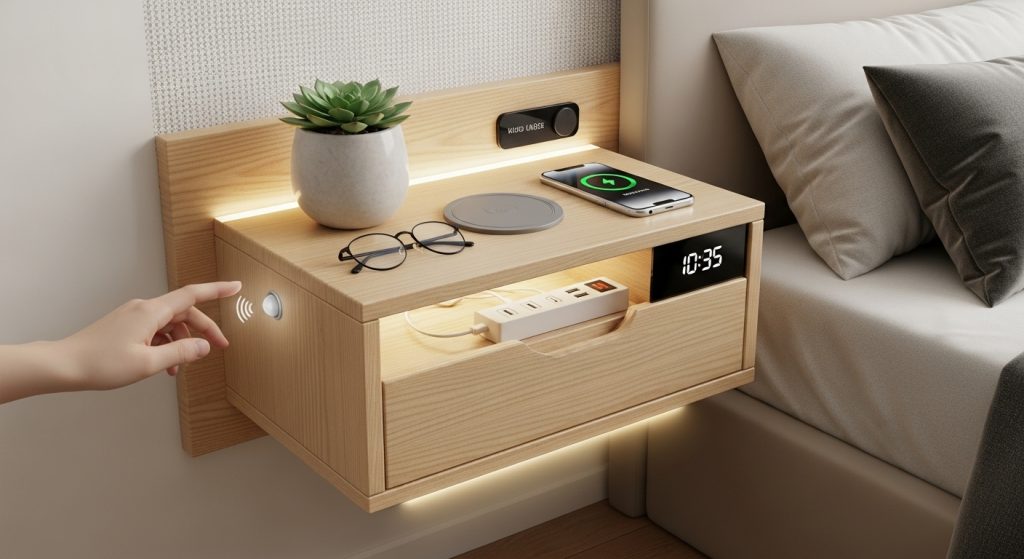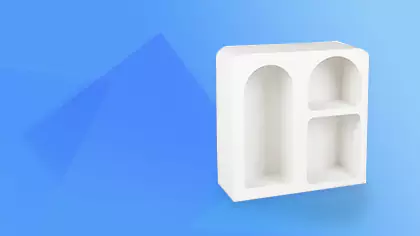Finding the perfect small bedroom nightstand ideas for tight spaces is a common challenge that requires creativity and a focus on maximizing both style and function. In a compact bedroom, every inch counts. A traditional, bulky nightstand can overwhelm the room, impede traffic flow, and make the space feel cramped. The solution lies in choosing smart, space-saving alternatives that provide essential bedside storage and surface area without sacrificing precious square footage.

This definitive guide provides expert insights and professional strategies. It explores innovative options like floating shelves, narrow-profile designs, multi-functional pieces, and clever styling tricks. It will empower you to create a beautiful, organized, and highly functional bedside area, even in the most challenging tight spaces.
What is the Core Principle of Nightstand Selection for Small Spaces?
The core principle is maximizing function within a minimal footprint. This involves choosing nightstand solutions that are physically compact, visually lightweight, and often multi-functional. The goal is to provide the necessary bedside convenience without adding visual clutter or taking up valuable floor space. Every choice should prioritize efficiency and the illusion of spaciousness.
This approach requires thinking vertically and embracing designs that appear to “float” or have a very light presence. It is about being resourceful and intentional. Instead of accepting limitations, a smart selection can turn a tight space into a stylish and surprisingly functional bedside zone. This philosophy aligns perfectly with the tenets of modern minimal bedroom furniture, where clean lines and uncluttered spaces are paramount. The increasing trend towards smaller living spaces globally makes these strategies more relevant than ever.
Why Are Floating Nightstands the Ultimate Space-Savers?
Floating nightstands – wall-mounted shelves or small cabinets – are the ultimate space-saving solution because they occupy zero floor space. By attaching directly to the wall, they provide a functional surface and storage while keeping the area underneath completely clear. This creates a powerful illusion of spaciousness and makes cleaning the floor much easier.
These designs are incredibly versatile. They can be installed at the exact perfect height relative to your mattress, regardless of bed frame height. Their minimalist aesthetic fits seamlessly into modern and contemporary decor styles. They are the go-to choice for designers working with extremely tight spaces.
How Do Simple Floating Shelves Work?
A simple floating shelf is the most minimalist option. It consists of a single shelf board mounted to the wall with hidden hardware, creating a clean, seamless look.
- Functionality: Provides a basic surface for essentials like a phone, a small lamp (or use a wall sconce above it), and a glass of water.
- Installation: Requires secure mounting into wall studs or using appropriate heavy-duty wall anchors to ensure stability.
- Styling: The lack of storage demands a highly curated, uncluttered approach, as detailed in our minimalist nightstand styling tips for clean interiors.
What Are the Benefits of Floating Cabinets or Drawers?
Floating cabinets or drawers offer the same floor-clearing benefits as shelves but with the added advantage of concealed storage. These are essentially small, wall-mounted boxes, often with a single drawer or a small door.
- Functionality: Provides hidden storage for items you want to keep out of sight (medications, chargers, personal items), helping to maintain a clean look.
- Installation: Requires very secure mounting due to the added weight and the stress of opening/closing drawers or doors. Professional installation is often recommended.
- Style: Available in various finishes (wood, lacquer) to match different decor styles. Handleless designs enhance the minimalist aesthetic.
What Are the Installation Considerations?
Proper installation is critical for the safety and stability of any floating nightstand.
- Locate Studs: Whenever possible, mount the shelf or cabinet directly into wall studs for maximum support. Use an electronic stud finder.
- Use Appropriate Anchors: If studs are not available in the desired location, use high-quality drywall anchors rated significantly higher than the expected weight load. Toggle bolts or screw-in anchors are generally more reliable than simple plastic plugs.
- Ensure Level Mounting: Use a level during installation to ensure the surface is perfectly horizontal. Improper installation can lead to the shelf sagging or detaching from the wall, which is a serious safety hazard.
How Can Narrow and Slim-Profile Nightstands Fit Tight Spaces?
If a wall-mounted solution is not feasible or desired, a freestanding narrow or slim-profile nightstand is the next best option. These tables are specifically designed with a shallow depth and often a narrow width to fit comfortably into tight corners or beside beds with minimal clearance.
The key is minimizing the physical footprint while maximizing the visual lightness. Look for designs that feel airy and open rather than solid and bulky.
Why is Shallow Depth the Key Dimension?
Shallow depth is the most critical dimension for a nightstand in a tight space. Look for options that are 12 inches deep or less. This minimal front-to-back measurement prevents the nightstand from jutting out excessively into the walkway around the bed. It maintains a clear path while still providing a usable surface area. Measure your available space carefully before shopping.
What Are “Leggy” Designs and How Do They Help?
“Leggy” designs, meaning tables with tall, slender legs and an open space underneath, are highly effective in small rooms. By allowing the eye to see the floor beneath the table, they create an illusion of greater spaciousness. The open design feels lighter and less imposing than a solid cabinet or a blocky shape. Look for simple post legs, elegant tapered legs, or modern hairpin legs.
What Materials Contribute to a Visually Light Feel?
The materials used play a significant role in the nightstand’s visual weight. For small spaces, choose materials that feel light and airy.
- Glass: A clear glass top with a minimal metal frame can almost disappear visually.
- Acrylic: Similar to glass, clear acrylic offers transparency and a modern feel.
- Light-Toned Woods: Natural oak, ash, or maple feel lighter and brighter than dark woods.
- Thin Metal Frames: Simple, open frames in black, white, or a light metallic finish feel less bulky than solid panels. Avoid heavy, dark woods or solid, blocky designs in very tight spaces.
What Are Some Examples of Slim Storage Solutions?
Even slim nightstands can offer storage. Look for designs that incorporate:
- A Single Slim Drawer: Provides just enough concealed storage for essentials without adding much visual bulk.
- A Narrow Open Shelf: Offers space for a book or a small basket.
- Minimalist C-Tables: These tables have a C-shaped base designed to slide partially under the bed or sofa, minimizing their footprint.
How Can You Utilize Vertical Space Effectively?
When floor space is limited, thinking vertically is a smart strategy. Utilizing the vertical space above and around the nightstand frees up the valuable tabletop surface and draws the eye upward, creating an illusion of height.
Why Are Wall-Mounted Sconces Ideal for Small Spaces?
Wall-mounted sconces are an ideal lighting solution because they completely eliminate the need for a table lamp. This frees up the entire nightstand surface for other items. Choose sconces with adjustable arms for reading light or simple, elegant designs for ambient light. Ensure the switch is easily reachable from the bed. This is a common feature in hotel-inspired nightstand styling for luxury vibes and works perfectly in small spaces.
How Can Narrow Wall Shelves Add Storage Above the Nightstand?
Installing one or two narrow wall shelves directly above the nightstand provides extra storage or display space without taking up any floor area. These shelves are perfect for holding books, small decorative objects, or even a small plant. Choose simple, floating shelves for a minimalist look. Ensure they are mounted high enough to avoid bumping your head but low enough to be easily reachable.
What About Tall, Narrow Nightstand Designs?
Instead of a traditional low, wide nightstand, consider a tall, narrow design, sometimes called a “pedestal” or “tower” nightstand. These pieces utilize vertical space for storage, often featuring multiple small drawers or shelves stacked vertically. Their small footprint makes them ideal for very tight corners beside the bed. Ensure the height is still ergonomically comfortable relative to your mattress.
What Are Multi-functional Furniture Alternatives to Traditional Nightstands?
Thinking outside the traditional “nightstand box” can reveal many creative and space-saving solutions. Sometimes, the best nightstand for a tight space is not a nightstand at all, but another piece of furniture repurposed for bedside duty.
Can a Small Stool or Plant Stand Work?
Yes, a small stool or even a sturdy plant stand can serve as a minimalist nightstand. They offer a simple surface for a phone and perhaps a very small lamp or book. Choose a stool with an interesting shape or material (like wood or metal) to add a touch of style. This is a very budget-friendly and space-conscious option, perfect for guest rooms or extremely tight spaces.
How Do C-Tables Maximize Floor Space?
C-tables are cleverly designed tables with a base shaped like the letter “C.” This allows the base to slide underneath the edge of a bed or sofa, bringing the tabletop surface closer to the user while minimizing the floor footprint. They are an excellent solution for very narrow gaps beside the bed where a traditional nightstand would not fit. They provide a convenient surface for a drink, book, or remote control.
Can a Small Dresser or Chest Double as a Nightstand?
In some cases, a small, low dresser or chest of drawers can serve as a nightstand, especially if you need significant bedside storage. This piece can hold clothing or linens while also providing a surface for a lamp and essentials. Ensure the height is appropriate for your bed. This multi-functional approach is a smart way to maximize storage in a small bedroom. The versatility of furniture is increasingly important for consumers.
What About Using Headboard Storage?
Some modern bed frames come with integrated headboard storage. This might include built-in shelves, niches, or even small drawers within the headboard itself. This eliminates the need for separate nightstands entirely, providing a very streamlined and space-saving solution. This is a popular feature in minimalist and space-conscious bedroom designs.
How Do You Style a Small Nightstand Without Clutter?
Styling a small nightstand requires a disciplined, minimalist approach. With limited surface area, every item must be chosen with intention. The goal is to create a look that is functional, beautiful, and completely free of clutter. This requires ruthless editing and smart organizational strategies.
Why is the “Less is More” Philosophy Crucial?
The “less is more” philosophy is absolutely crucial. A small surface cannot accommodate a large number of items without looking chaotic. Limit yourself to the absolute essentials. Typically, this means:
- A light source (ideally wall-mounted, or a very slender lamp).
- A place for your phone/alarm.
- Perhaps one small personal item (a tiny plant, a single framed photo). Resist the urge to add more. Embrace the negative space. Our guide on minimalist nightstand styling tips for clean interiors provides a detailed framework.
How to Maximize Vertical Space Within the Nightstand?
Maximize storage within the nightstand itself. Use small drawer dividers or containers to organize items inside drawers. Utilize vertical space on open shelves by using small stacking boxes or stacking books vertically with bookends. The goal is to keep as much as possible off the precious top surface. Our guide on bedside organization tips using small modern nightstands offers many clever solutions.
What is the Role of a Small Tray or Bowl?
Even on a tiny nightstand, a very small tray or bowl can be invaluable. It serves as a designated spot for tiny items like rings, earrings, or lip balm that might otherwise get lost or create visual noise. Choose a tray with a minimal footprint and a simple design.
How Can You Use the Wall Space Above?
Utilize the wall space above the nightstand for elements that would normally sit on the table. As mentioned, wall sconces are ideal for lighting. A small, floating shelf mounted just above the nightstand can hold books or decorative items. A wall-mounted phone holder or charging station can also free up surface space.
Conclusion
These small bedroom nightstand ideas for tight spaces demonstrate that limited square footage does not have to mean limited style or function. By choosing space-saving designs like floating shelves or narrow-profile tables, utilizing vertical space effectively, embracing multi-functional alternatives, and adopting a minimalist styling approach, you can create a bedside area that is both beautiful and highly practical. The key is intentionality and creativity. With the right strategies, even the tightest space can accommodate a chic and functional nightstand solution, contributing to a serene and well-designed bedroom sanctuary.











